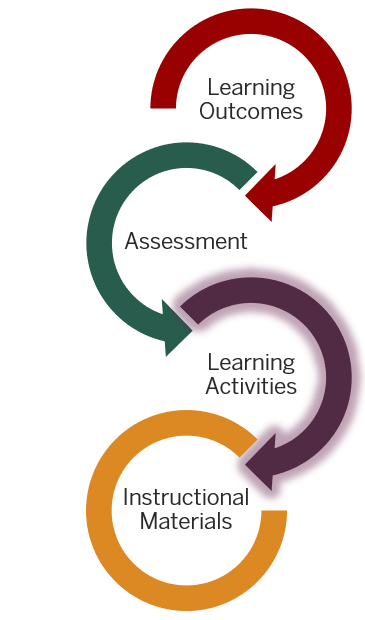Online Teaching and Learning (Chapters)
Chapter 8: Learning Activities
Learning Activities


Once you have decided on a plan for designing your course, you will need to start thinking about learning activities that will lead your learners to the desired outcomes. Active interaction is at the heart of the online teaching and learning process.
While passive activities, such as reading a text or listening to a lecture are technically learning activities, active learning activities are more effective in helping students learn and develop. If students are actively involved in working with the content, research has shown that they learn more, are more satisfied, and are more successful in the course.
It is fairly easy to spot active learning in an in-person classroom. In most in-person courses, students complete activities designed to help them learn material and develop competencies or skills. For example. students working together in pairs or small groups to solve problems, answer questions, or brainstorm ideas are active learning. So is classroom discussion where the whole class is engaged in dialogue with each other and the instructor.
Some types of note-taking, like Cornell notes, are also active learning. Classroom assessment techniques (Angelo & Cross, 1993 ), which are small formative assessments done in a few minutes in class, are also examples of interacting with the content. Out-of-class activities – a.k.a homework – normally have students actively work with course concepts, individually or in groups.
The question is, how does this all look online?
Online Active Learning Activities
As you design your course, you will need to start thinking about how you can have your learners actively participating.
Engaging learning activities require students to participate actively and think deeply about the concepts they are mastering and can also lead to increased student motivation and success. In this video, faculty provide some practical strategies and tools to promote student engagement and active learning in the design of online course activities.
Types of Student Interactions
When talking about online courses, researchers focus on three types of student interaction:
- student-instructor (email, discussions, feedback on assignments)
- student-student (synchronous and asynchronous discussions, group work, peer reviews)
- student-content (assigned readings, lecture materials, PowerPoint presentations)
It is helpful to think through the balance of interaction over the entire course. Particularly, providing activities that offer a range of student-student interaction (from substantial to moderate to light to none) allows students with different preferences for the amount of peer interaction to be comfortable at some points and challenged to expand their comfort zone at others.
Providing “hands-on” activities for students, either individually or in small groups, is an important way to increase motivation and support learning. For more ideas for online activities, see a Toolkit of Active Learning Options for online teaching and learning from the Active Learning in Higher Education Journal.
Connecting and Reflecting
Active learning is more than just “doing things.” Fink (2005) suggests thinking about active learning as a combination of
- doing things (or observing others doing things),
- connecting it with other information and ideas, and
- reflecting on what it means.
Connecting and reflection (2 and 3) are important aspects of learning as, without making connections and understanding how what they have learned fits in with the other things they already know, the learning is disconnected and likely to soon be forgotten. Just because they do a thing, does not mean they understand it’s purpose and meaning.
You can ask students to contextualize content or concepts and reflect on their meaning individually in a learning journal or blog or a series of minute papers. They could also work with a peer in a think-pair-share activity or a synchronous or asynchronous video or audio debrief or with a small group in a discussion or by generating a collaborative mindmap or outline for example.
Another way to do this is by using thinking routines. Having students verbalize and share their understanding can turn up misconceptions that may be hindering their learning without them being consciously aware of it. Like a formative assessment, you can use this information to revisit things that appear to be challenging for multiple students. The following short video from MIT’s Project Zero describes thinking routines and their use.
A thinking routine such as:
- Connect: How are these ideas and information CONNECTED to what you already knew?
- Extend: What new ideas did you get that EXTENDED or pushed your thinking in new directions?
- Challenge: What is still CHALLENGING or confusing for you? What questions or puzzles do you now have?
This routine can be a useful end-of module reflection prompt—done individually, in pairs, or in small groups. It can also be useful to the instructor, as it will show what students think they are learning and what is still confusing.
Reflective thinking routines can be ungraded or they can be marked complete/incomplete and count toward participation or as a substitute for attendance.
Communication Strategies
Faculty member Ashley Taylor, talks about her communication strategies for teaching online, including adding a Q & A page, using discussion posts to encourage community, and using polls in Quizzes to keep tabs on how the students feel during the semester.
Chapter Questions
- Describe the importance of active learning in an online course.
- Explain two ways an instructor can incorporate active learning into an online course even if it is mostly asynchronous.
- List the three types of student interactions mentioned in this chapter. Explain why is balancing them in an online course is important.
- According to Fink’s perspective on active learning, what are the three key components of effective learning experiences?
- Define thinking routines and explain how they can be used in an online course.
- Specify how faculty communication strategies can have an effect on the effectiveness of online learning activities.
- Illustrate time you could use a survey or discussion to actively engage your online students.
